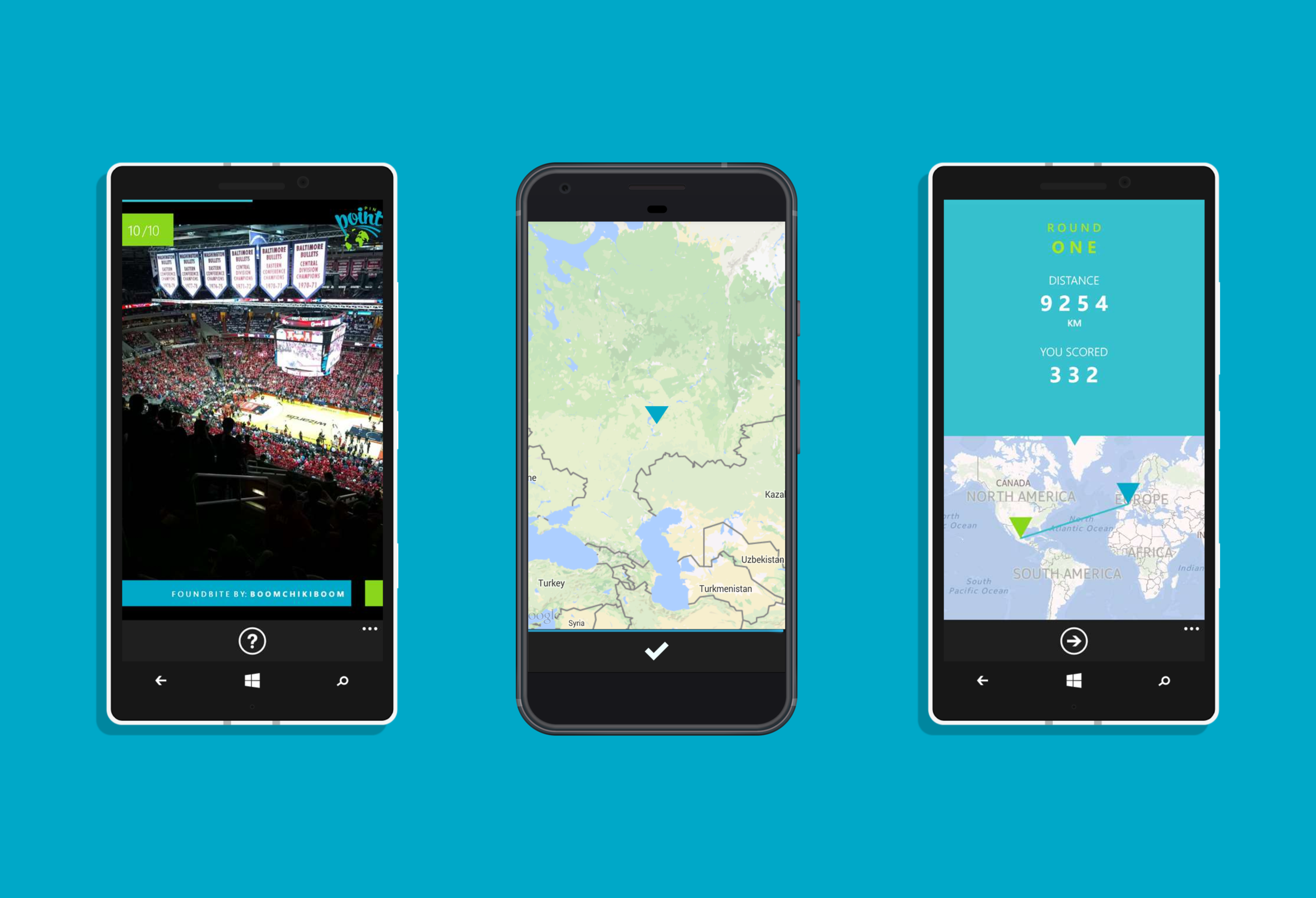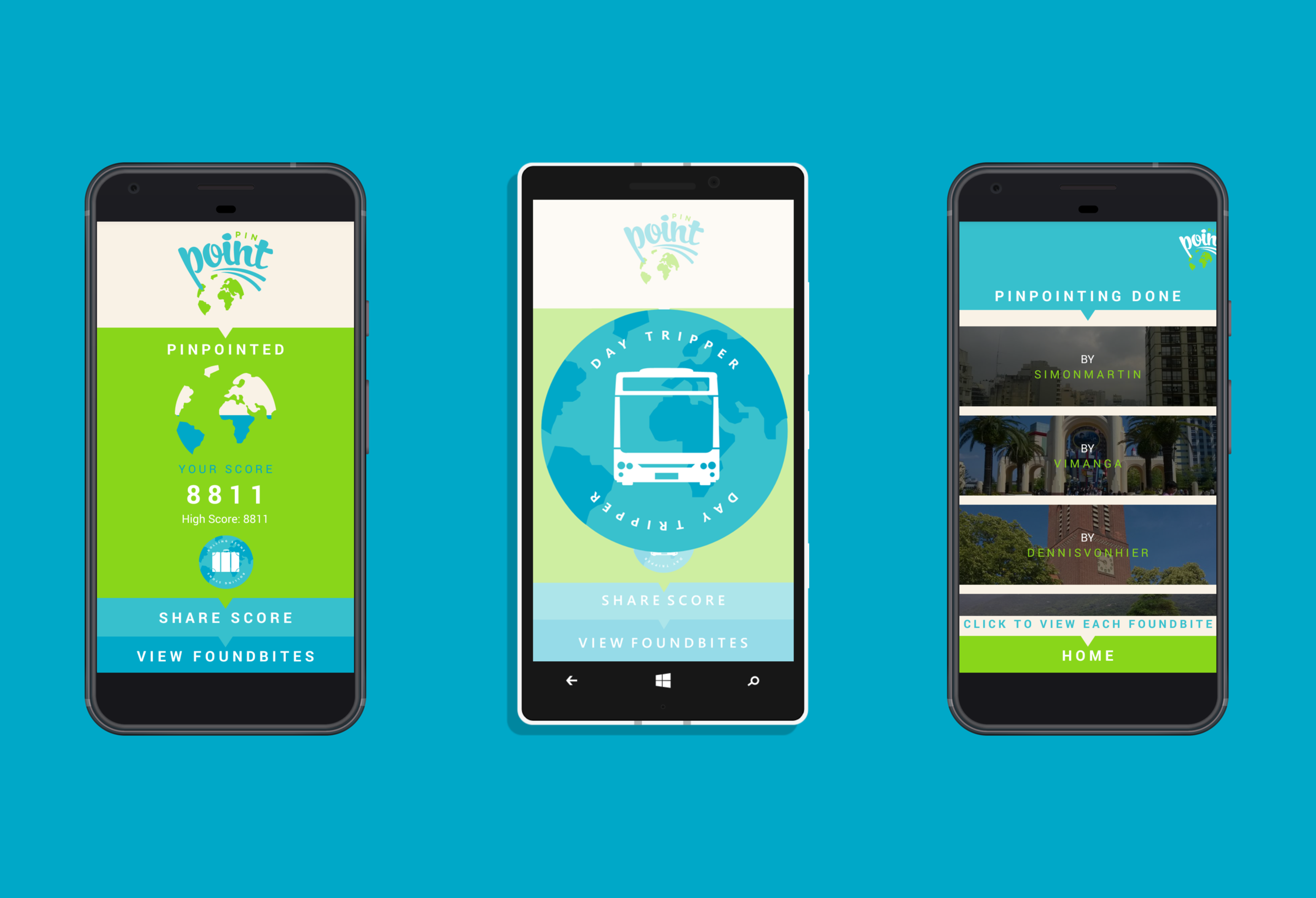Foundbite was an app for iOS, Android and Windows Phone that allowed users to share sights and sounds encountered around the world – from trickling streams high in the Austrian Alps, to buskers in Berlin or street festivals in Brazil (read more about it here).
As fascinating photos and recordings poured in, we started to experiment with ways to use some of these uploads to create interesting and novel experiences that played to the strengths of the app. The outcome was Pinpoint, a game that showed users 10 foundbites (photos and sounds) uploaded by the Foundbite community anywhere in the world and challenged them to guess where they had been recorded, interpreting the information available. The closer you were to the spot the higher your score. It was a simple concept, showcasing the variety of wonderful sounds people were uploading to Foundbite with the aim of generating more attention for it, particularly before our Android launch.
A Game as Marketing?
By January 2015 the Foundbite app for Windows Phone had passed the 100,000 download mark and users could share their creations in the app, where they would feature on a feed, or with other users externally, on Facebook or Twitter for example, using a link to our site. Uniquely, the app also featured a map displaying every foundbite uploaded with a geolocation – this proved one of the most popular areas in the app. You could explore a place on the other side of the world and really get a feel for what it was like to be there. To participate in this landscape, more and more foundbites were uploaded with a location. We started looking for ways to help people view and find more of the foundbites and to advertise the service by showing the creative ways people were using the app. After playing around with several ideas, we settled on a game idea that became Pinpoint. We derived a some inspiration from another game popular at the time, GeoGuessr.

GeoGuessr used Google Street View to teleport you to a random place in the world where you could pan and roam around as you would normally, except you couldn’t zoom out to see where you were on a map. In order to deduce your location you had to move around looking at street signs, cars, trees, making note of any clue. Once you felt ready, you could make a guess by placing a pin on a map where you thought you were. How far you were away from the real location dictated your score. It was a huge hit and quickly went viral online. I wasn’t alone in loving the simple detective work that had to go into making a decent guess. Sometimes it was surprisingly easy, other times it was almost impossible!
Building our Game
We used similar mechanics to GeoGuessr in our game, but instead of Google Street View we picked 500+ of the best foundbites that had locations and captions with clues, which we removed. Examples included a hockey game in the US where you could read the club name on the jumbotron if you zoomed in, a panorama of Tehran with the sound of a call to prayer, a tour guide in London where you could hear the location he was talking about, and a football game where you could see shirt colours and hear the crowd speaking in German. Subtle clues, and very few where you could guess the exact location, but as with GeoGuessr it was all about stoking your curiosity, using your skills of observation and giving it your best guess. On the final page of the game users were able to click on the 10 foundbites they had played and see them in the main app (or get prompted to download it if they were new), so they could “follow” the user who took it or to leave a comment. We hoped this would be a fantastic way for people to discover others to follow and create engagement around foundbites new and old.

As we already had a significant audience on Windows Phone, we built the game for this platform first. We created a simple but bold and fun UI with nice animations to reveal the location using XAML and badges to grade your score after you had guessed 10 foundbites – ranging from Couch Potato and Day Tripper all the way to the illustrious title of Globe Trotter. At launch, Pinpoint was well received by existing and new users and it generated some press attention for both apps on sites like Windows Central and the Nokia Connections blog.
After that, we began to build Pinpoint for Android as well. Foundbite hadn’t yet launched on Android, but we thought that if we saw the same kind of reception as we had had on Windows we could raise awareness and collect signups ahead of the launch. Alfie Woodland, who was the other half of the Foundbite team, took the lead on the build and I chipped in here and there. At this point neither of us had built an Android app before so we also figured building this game would be a nice introduction to the platform before building the larger and far more complex Foundbite app for Android. As for tooling, we decided to build with Xamarin, Microsoft’s native cross platform framework, given our .NET experience. It would also mean being able to share the logic that processed scores and retrieved foundbites from our API across iOS, Android and Windows – a big time saver.
Reception
After several months of hard work we launched the game on Android with the same fun UI and experience. However, compared to our launch on Windows Phone it was a far smaller affair. Windows Phone had a comparatively small but active community always looking out for the rare new apps to come to the platform, but on Android we were just one new app in a sea of other apps both good and bad. In an email newsletter to our existing users we managed to reach people who had downloaded the app before moving to Android and others who had signed up to hear about our launch but, in all honesty, the downloads were pitiful – just shy of 400. We’d definitely been spoilt by the partners we’d had on Windows, such as Microsoft and Nokia, who were eager to promote developers building for the smallest major mobile operating system. Not unfairly, Google doesn’t really give much in way of promotion on the Play store until you’ve already got significant traction off your own back – naively, we hadn’t really considered this.

For comparison, on Windows Phone the app was downloaded more than 37,000 times, netting 299 reviews and an average rating of 4.3/5. One in four game plays resulted in someone following the foundbite links into the app, where many left comment or followed the poster. Not everyone was a fan, of course, and a few of the foundbites we initially had were far too subtle/borderline impossible to discern where they were from (e.g.: a picture of a beach) but in general we had some lovely reviews:
This app is wonderful. Not only is it a great way to learn about different cultures, but a great way to discover different attractions!”
— Anonymous, USA
“A beautifully presented geography guessing-type game; the audio adds an intriguing, atmospheric layer”
— Arthur, Australia
“Culturally interesting and fun. Worth downloading and trying to guess the places in the world.”
— Rafael, Brazil
It turns out people particularly enjoyed playing the game with friends, and the community-powered aspect. They were also quite big fans of seeing their own foundbites picked for others to guess.
While producing a fun product that people enjoy using is, of course, nice and something to be proud of, in retrospect I’ve come to see that Pinpoint was ultimately a distraction from improving and solving problems with the main Foundbite service. We spent months building and creating this sideshow product we hoped might go viral and attract a lot more people to sign up for the app (as well as dramatically increasing the time our existing users would spend in the app). On Windows Phone it was popular, but where we really needed users, on other platforms, it was a flop and suffered from many of the issues we would later face around distribution on iOS and Android.
Lessons Learnt
Even in failures and mistakes though there are often significant positives to take away: It was an invaluable learning experience for us as a team, as we made our first Xamarin app and it introduced us to Android, an experience we put into good use expanding Foundbite beyond Windows Phone. It also taught us the importance of discipline and focus when building a product or startup, and to avoid the allure of a shiny new side project or feature without proper consideration!
To read more about Foundbite and our experiences building the product why not check out this post.